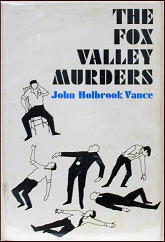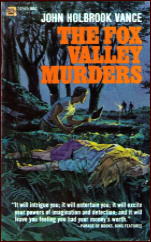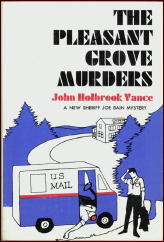Mon 7 Oct 2013
A 1001 MIDNIGHTS Review: JOHN HOLBROOK VANCE – The Fox Valley Murders
Posted by Steve under 1001 Midnights , Obituaries / Deaths Noted , Reviews[4] Comments
by Bill Pronzini
JOHN HOLBROOK VANCE – The Fox Valley Murders. Bobbs-Merrill, hardcover, 1966. Ace, paperback, no date [1972].

John Holbrook Vance is one of a handful of writers who have won major awards in two different genres. In the science-fiction field, where he writes as Jack Vance, received a Hugo for his 1963 novel The Dragon Masters — and in the mystery field, he received a Best First Novel Edgar for his 1960 tale of intrigue in Tangier, The Man in the Cage.
Vance has published a dozen mysteries, most of the formal variety. The two best feature Sheriff Joe Bain of the fictional central California county of San Rodrigo; The Fox Valley Murders is the first of these.
A smallish agricultural county south of San Jose, San Rodrigo is loosely modeled on the one in which Vance spent his childhood. He portrays it with a great deal of feeling and clarity, utilizing a variety of towns and rural settings much as Dennis Lynds, writing as John Crowe, would do a few years later in his “Buena Costa County” series.
People and places are so strikingly depicted, and county history, social problems, and politics so well integrated into the narrative, that San Rodrigo inhabitants seem utterly real.
In The Fox Valley Murders, Bain — a wild youth who has settled down to become a very good lawman — has been appointed acting sheriff after the recent death of old Ernest Cucchinello, the incumbent for many years and a man not above a little corruption. The county elections are not far off.

Bain wants the sheriff’s job permanently, campaigns hard for it, but is facing stiff competition from a well-backed progress-and-reform group. He is also facing a volatile situation centered around Ansley Wyett, a native of the town of Marblestone, who was convicted sixteen years before — despite his protestations of innocence — of the brutal rape/murder of a thirteen-year-old girl. Now out of San Quentin on parole and back home, Wyett has written the same letter to eachof the five men whose testimony sent him to prison, asking: “How do you plan to make this up to me?”
It isn’t long before the five recipients begin to die one by one in apparent accidents. Is Ausley responsible? And if not, then who is? And why? And, just as important, how? How do you make a man die of a heart attack in front of a witness (Bain himself)? How do you cause a man who has been picking mushrooms all his life to eat a poisonous toadstool? How do yon make someone fall off a ladder and break his neck in full view of his wife, with no one else around?
Bain is hard-pressed to find the answers before local citizens decide to take the law into their own hands and/or the election sweeps him right out of office.
Brimming with suspense, evocatively written, ingeniously constructed (with a number of dovetailing subplots and plenty of clues for the armchair detective), this is a first-rate novel that “fills the bill for real entertainment in the true sense of the word” (King Features Syndicate).

Almost as good is Joe Bain’s second case, The Pleasant Grove Murders (1967), in which the likable and very human sheriff once again faces political problems and a baffling multiple homicide (three brutal hammer murders).
Notable among Vance’s other mysteries are a pair under pseudonyms, both published in 1957 — Isle of Peril, as by Alan Wade, and Take My Face, as by Peter Held; The Deadly Isles (1969), a tale of murder in Tahiti and the Marquesas; and Bad Ronald (1973), a psychological thriller.
———
Reprinted with permission from 1001 Midnights, edited by Bill Pronzini & Marcia Muller and published by The Battered Silicon Dispatch Box, 2007. Copyright © 1986, 2007 by the Pronzini-Muller Family Trust.
R.I.P. JOHN HOLBROOK VANCE (1916-2013). Jack Vance died last May at the grand old age of 96. He was far better known for his works of fantasy and science fiction. Personally I have been reading his novels and short stories since I was in my teens, and I hope to for many more years. It is his wonderful, often playful use of words and the English language that I will remember the most.
October 7th, 2013 at 11:13 am
I enjoyed both novels very much. Sheriff Joe Bain represents the optimistic and tolerant spirit of the sixties.
October 11th, 2013 at 8:46 am
Jack Vance wrote some good mysteries. And his Science Fiction tales also had elements of mystery in them, too.
October 11th, 2013 at 11:46 am
I really liked both of these. Vance was a favorite of mine in any guise.
October 11th, 2013 at 12:39 pm
I’ve only read the SF-F by Vance, none of the mysteries. This sounds like a good one.